The fertilizers outlined here are compound fertilizers composed of primary fertilizers and secondary nutrients. These represent only one type of fertilizer, and other single nutrient types are also made. The raw materials, in solid form, can be supplied to fertilizer manufacturers in bulk quantities of thousands of tons, drum quantities, or in metal drums and bag containers.
Primary fertilizers include substances derived from nitrogen, phosphorus, and potassium. Various raw materials are used to produce these compounds. When ammonia is used as the nitrogen source in a fertilizer, one method of synthetic production requires the use of natural gas and air. The phosphorus component is made using sulfur, coal, and phosphate rock. The potassium source comes from potassium chloride, a primary component of potash.
Secondary nutrients are added to some fertilizers to help make them more effective. Calcium is obtained from limestone, which contains calcium carbonate, calcium sulphate, and calcium magnesium carbonate. The magnesium source in fertilizers is derived from dolomite. Sulfur is another material that is mined and added to fertilizers. Other mined materials include iron from ferrous sulfate, copper, and molybdenum from molybdenum oxide.
Ammonium Nitrate
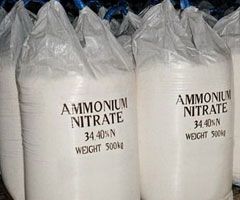
Urea 46% Nitrogen
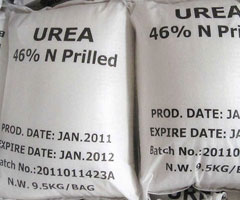
Diammonium Phosphate
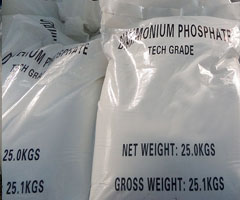
The Manufacturing Process
Fully integrated factories have been designed to produce compound fertilizers. Depending on the actual composition of the end product, the production process will differ from manufacturer to manufacturer.
Nitrogen fertilizer component
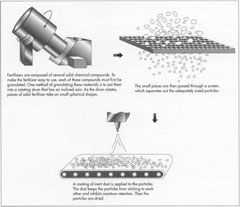
Ammonia is one nitrogen fertilizer component that can be synthesized from in-expensive raw materials. Since nitrogen makes up a significant portion of the earth’s atmosphere, a process was developed to produce ammonia from air. In this process, natural gas and steam are pumped into a large vessel. Next, air is pumped into the system, and oxygen is removed by the burning of natural gas and steam. This leaves primarily nitrogen, hydrogen, and carbon dioxide. The carbon dioxide is removed and ammonia is produced by introducing an electric current into the system. Catalysts such as magnetite (Fe3O4) have been used to improve the speed and efficiency of ammonia synthesis. Any impurities are removed from the ammonia, and it is stored in tanks until it is further processed.
While ammonia itself is sometimes used as a fertilizer, it is often converted to other substances for ease of handling. Nitric acid is produced by first mixing ammonia and air in a tank. In the presence of a catalyst, a reaction occurs which converts the ammonia to nitric oxide. The nitric oxide is further reacted in the presence of water to produce nitric acid.
Nitric acid and ammonia are used to make ammonium nitrate. This material is a good fertilizer component because it has a high concentration of nitrogen. The two materials are mixed together in a tank and a neutralization reaction occurs, producing ammonium nitrate. This material can then be stored until it is ready to be granulated and blended with the other fertilizer components.
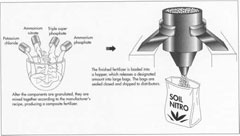
Phosphorous fertilizer component
To isolate phosphorus from phosphate rock, it is treated with sulfuric acid, producing phosphoric acid. Some of this material is reacted further with sulfuric acid and nitric acid to produce a triple superphosphate, an excellent source of phosphorous in solid form.
Some of the phosphoric acid is also reacted with ammonia in a separate tank. This reaction results in ammonium phosphate, another good primary fertilizer.
Potassium fertilizer component
Potassium chloride is typically supplied to fertilizer manufacturers in bulk. The manufacturer converts it into a more usable form by granulating it. This makes it easier to mix with other fertilizer components in the next step.
Granulating and blending
To produce fertilizer in the most usable form, each of the different compounds, ammonium nitrate, potassium chloride, ammonium phosphate, and triple superphosphate are granulated and blended together. One method of granulation involves putting the solid materials into a rotating drum which has an inclined axis. As the drum rotates, pieces of the solid fertilizer take on small spherical shapes. They are passed through a screen that separates out adequately sized particles. A coating of inert dust is then applied to the particles, keeping each one discrete and inhibiting moisture retention. Finally, the particles are dried, completing the granulation process.
The different types of particles are blended together in appropriate proportions to produce a composite fertilizer. The blending is done in a large mixing drum that rotates a specific number of turns to produce the best mixture possible. After mixing, the fertilizer is emptied onto a conveyor belt, which transports it to the bagging machine.
Bagging
Fertilizers are typically supplied to farmers in large bags. To fill these bags the fertilizer is first delivered into a large hopper. An appropriate amount is released from the hopper into a bag that is held open by a clamping device. The bag is on a vibrating surface, which allows better packing. When filling is complete, the bag is transported upright to a machine that seals it closed. The bag is then conveyored to a palletizer, which stacks multiple bags, readying them for shipment to distributors and eventually to farmers.


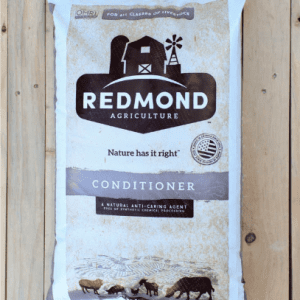
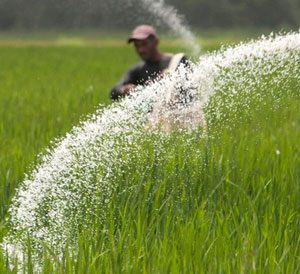
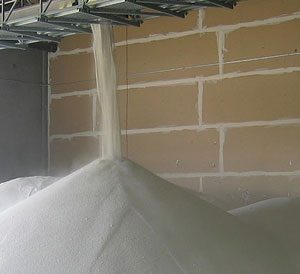

There are no reviews yet.